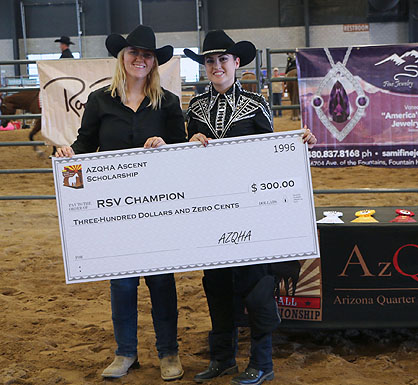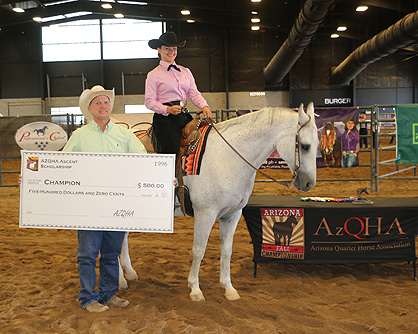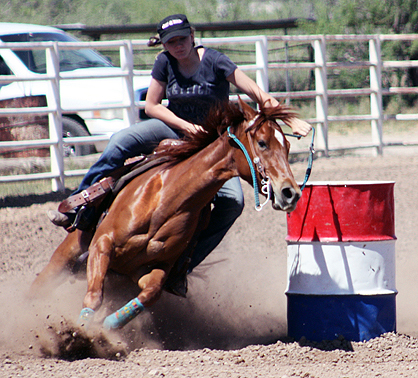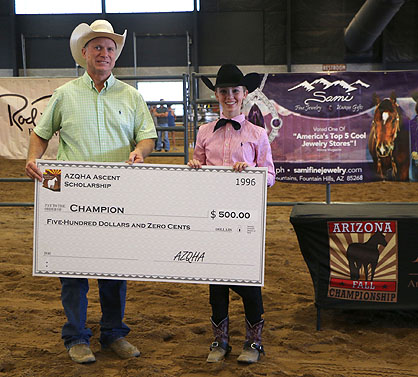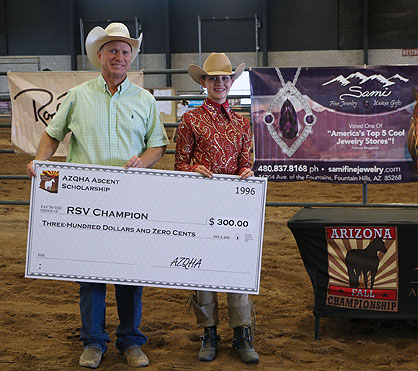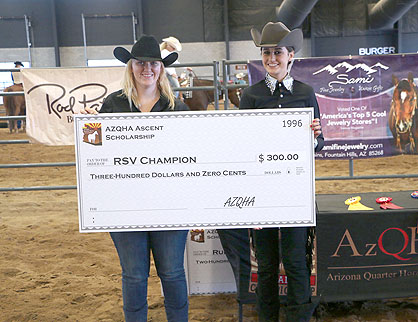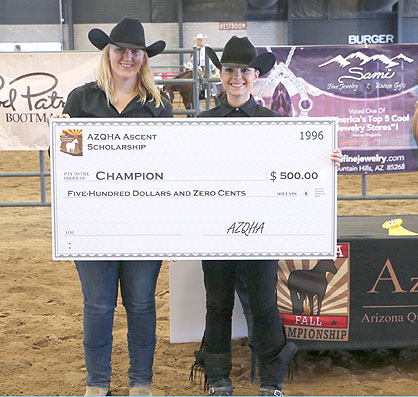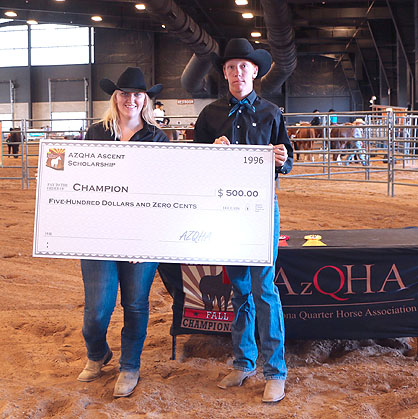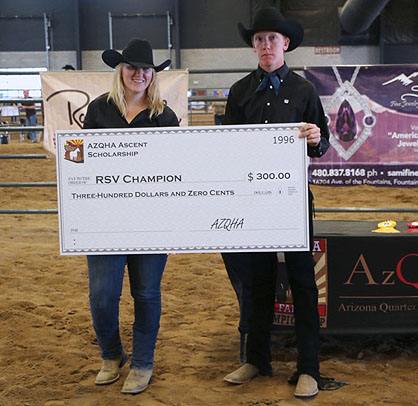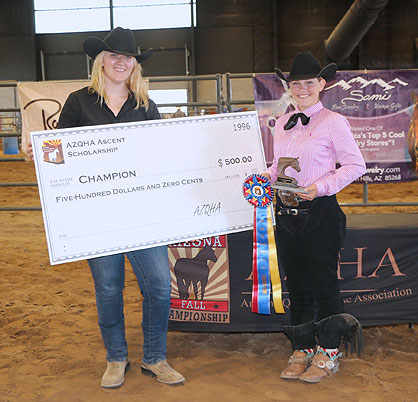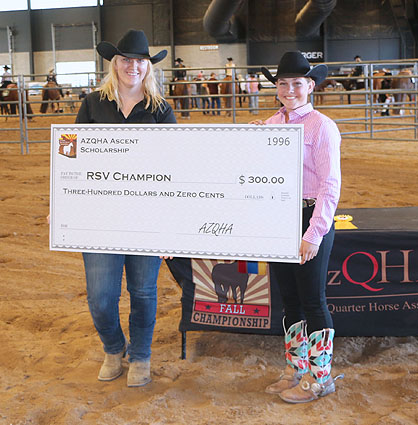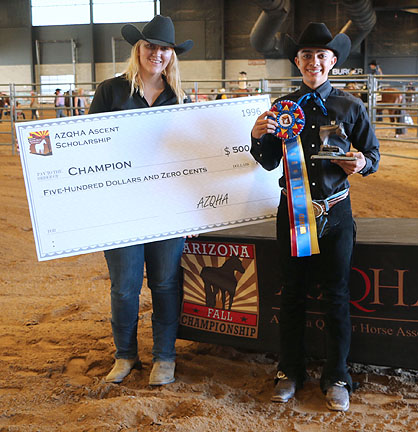$15,000 Awarded in Scholarship Money at 2017 AZ Fall Championship
By: Kristin Spinning
The Arizona Quarter horse Association is passionate about youth and is committed to assisting future generations to rise up to the next level through education. The Ascent Scholarship Program, sponsored by Dr. Joni Hegel, was established to be a mechanism to inspire youth to show in AQHA activities while simultaneously planning for their educational future. Participants must be an AzQHYA and Interscholastic Equestrian Association (IEA) member and compete in at least one class at two of the three AzQHA No Bling shows to be eligible. Scholarship money earned by exhibitors is kept in a restricted account by AzQHA until they graduate from high school. Scholarships are paid directly to the college, trade school, or university that student attends. Over time, youth members can accumulate a significant amount for their educational goals.
The 2017 Arizona Fall Championship hosted two scholarship events at WestWorld in Scottsdale, Arizona: an Interscholastic competition and the Joe and Suzy Jeane Scholarship Contest, an interview based selection process.
Five $1,000 scholarships were awarded based on the interviews conducted at the AZFC. Applicants had to answer a series of questions in front of a four person panel. Interest exploded over this wonderful opportunity, and 23 kids went through the process. Questions probed their current and future involvement in the equine industry, career goals, and how they have participated in community service and outreach to promote the Quarter Horse industry.
AzQHA President and interview panelist, Michele Pearson, remarked that while many youth were undoubtedly nervous, they were all well-prepared and conveyed their stories admirably. A common theme emerged about how the youth had transformative life lessons from working with horses. Pearson was very enthusiastic regarding this round of giving and the future of the scholarship program as a whole. Scholarship winners were Kaylee Hamm, Shandin Farrel, Kate Buchanan, Ariel Olvey, and Quinn Eisenfeld.
The AzQHA Interscholastic Competition offered classes in Horsemanship and Reining for different levels of experience. Trophies and ribbons were awarded and eligible riders were able to earn scholarship money. Horses were provided at the competition, free of charge, by volunteers and were drawn by exhibitors for each class. Each of the 10 classes at the AZFC show awarded $1,000 worth of Ascent Scholarship money for eligible youth. First place received $500, second got $300, and third place had $200 credited to their account.
Most of the riders in the Interscholastic competition were active members on IEA teams. IEA is a national organization that’s open to public school, private school, and barn teams for grades 6-12. The students compete at several shows within their state every year and can go to the Regionals or qualify for the national finals. Arizona has several coaches covering both English and Western disciplines. The bulk of the teams are in the Phoenix metro area, and there is one Hunt Seat team in Tucson. IEA youth do not need to own a horse to join a team.
Ben Balow, who’s son, Ben, was riding in the competition, commented on the benefits of IEA to the horse industry. “It brings kids in to showing that may not otherwise have a chance to participate,” he explains. “They can go to a qualified trainer in the area and take lessons, without owning a horse.” The program makes it more feasible for the general public to get involved with horse showing. “The kids can see an achievable goal and pursue it without having to buy the real expensive horse.” A good number of the kids find IEA is a launch pad for showing in AQHA or NRHA. Others pursue collegiate equine teams. “To me, it’s invaluable to have this kind of program in our state,” Balow says.
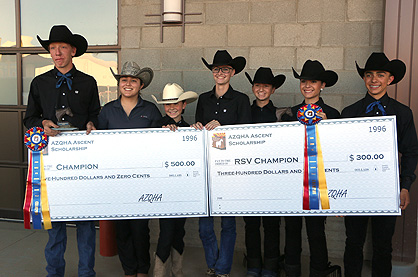 Holly Hover has been a large supporter of IEA. At the conclusion of Sunday’s competition, she commented, “I so appreciate the opportunity that Arizona Quarter Horse gave to all of these students. I know it was a focal point of their whole year. She noted that parents, grandparents, aunts, and uncles all came out to support their kids. Hover recognizes the long-term benefits the program has on the horse industry. “In my group, I see about 20% attrition rate of kids going on to show at Quarter Horse shows.” She views it as the ideal opening for families who have interest, but have not had the opportunity to become involved with horses. “It’s been a great outreach program.”
Holly Hover has been a large supporter of IEA. At the conclusion of Sunday’s competition, she commented, “I so appreciate the opportunity that Arizona Quarter Horse gave to all of these students. I know it was a focal point of their whole year. She noted that parents, grandparents, aunts, and uncles all came out to support their kids. Hover recognizes the long-term benefits the program has on the horse industry. “In my group, I see about 20% attrition rate of kids going on to show at Quarter Horse shows.” She views it as the ideal opening for families who have interest, but have not had the opportunity to become involved with horses. “It’s been a great outreach program.”
The donated horses come from a variety of backgrounds. Hover maintains a string of about 10 team horses. Some of them have been shown extensively and are now retired. Their owners understand the importance of having good quality, safe horses to ride and to inspire the next generation. Hover appreciates the diverse support IEA has garnered, saying, “The Arizona community has been remarkable in helping with the program.”
Arizona teams are welcoming new members. The IEA website, rideIEA.org, has a map of all the team locations and participating trainers. AzQHA.org has information on Arizona competitions as well as scholarships offered by AzQHA and AQHA. Scroll below to view more photos of scholarship winners.










